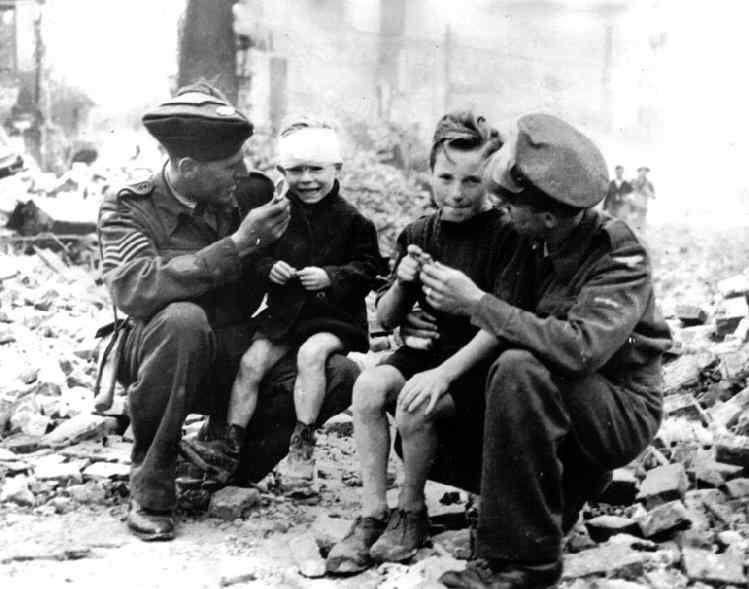
D-Day: Normandy--La Harve (September 12, 1944)

Figure 1.--This Internation News Photo was captioned, "How to win friends and etc." The caption read, "Sergeant G.R. Bell and Leding Aircraftsman W.A. Holmes, members of the British force that captured Pont L'Eveque, 14 miles south of La Harve, make friends of two local boys by the simple expedient of feeding them chicolate. One of the boys suffered a head injury when the Germans set fire to the center of the town before they retreated." The boys certainly seem to be enjoying ther chocolate. After 4 years of German occupation, it was probably the first they had ever tasted. The photograph was taken September 9, a few days before Le Harve itself fell to the Allies. A French reader writes, "A touching image. I am sure these young boys never forgot this fine gesture and those British soldiers with their chocolate."
|
|
Le Harve was after Cherbourg, the next most important port in the Normandy area and thus was of enormous importance. The Germans had important radar sites at La Harve E-boat pens at La-Harve. These were targeted by Allied air attack even before D-Day. It was, however, located just outside the initial Normandy landing sites. The Allies knew that Le Harve would be strongly fortified and because it was located just north of the Seine, did not go for it on the first day. It was tntalizingly close, but just out of reach. Putting a force across the Seine would have exposed them to a German couter attack. As it worked out, the German Le Harve garrison resisted even after the Allies crossed the Seine and the port was surounded. Hitler and the Whermacht OKW believed that wihout ports, the Allies could not support a major offensive.
The Allies conducted naval operations off Le Harve to supress German E-boat activity before the break out from Normandy ebnabled land forces to cross the Seine.
The American breakout at St. Lo, forced a general German withdrawal from Normandy toward the Seine (July 27).
The Allies at first planned to stop at the Seine, but the offensive was so successful that Patton's 3rd Army was ordered to cross the Seine. Supreme Commander General Dwight D. Eisenhower approved Patton's plan to force a bridgehead east of Paris.
Patton’s armour reached the Seine at Nantes and made the first crossing 30 miles North West of Paris (August 19). Montgomery also crossed the Seine further east and drove north.
The Germans left garisons in the Channel ports with orders to fight to the death. Fighting in the city was very heavy. The city was almost totally destoyed by the Germans to destroy the port and the Allied trying to take what was left. The Germans did not surrender until September 12, by that time the Allies had reached Belgium and had liberated most of France. The German surrender was the final chapter of the D-Day campaign. Le Harve was to play a role after the War. It was a major embarcation point for thousands of GIs returning home. The first GIs to return home were those wounded in cobat and then the POWs liberated from German camps. La Harve had to be almost completely rebuilt after the War. It is today France's most important foreign trade port and the fifth largest European port.
HBC

Navigate the Boys' Historical Clothing Web Site:
[Return to Main World War II Normandy page]
[Return to Main D-Day page]
[Return to Main French World War II page]
[Return to Main U.S. World War II page]
[About Us]
[Biographies]
[Campaigns]
[Children]
[Countries]
[Deciding factors]
[Diplomacy]
[Geo-political crisis]
[Economics]
[Home front]
[Intelligence]
[POWs]
[Resistance]
[Race]
[Refugees]
[Technology]
[Totalitarian powers]
[Bibliographies]
[Contributions]
[FAQs]
[Images]
[Links]
[Registration]
[Tools]
[Return to Main World War II page]
[Return to Main war essay page]
[Return to CIH Home page]
Created: 12:15 AM 3/13/2008
Last updated: 5:28 PM 12/5/2008



